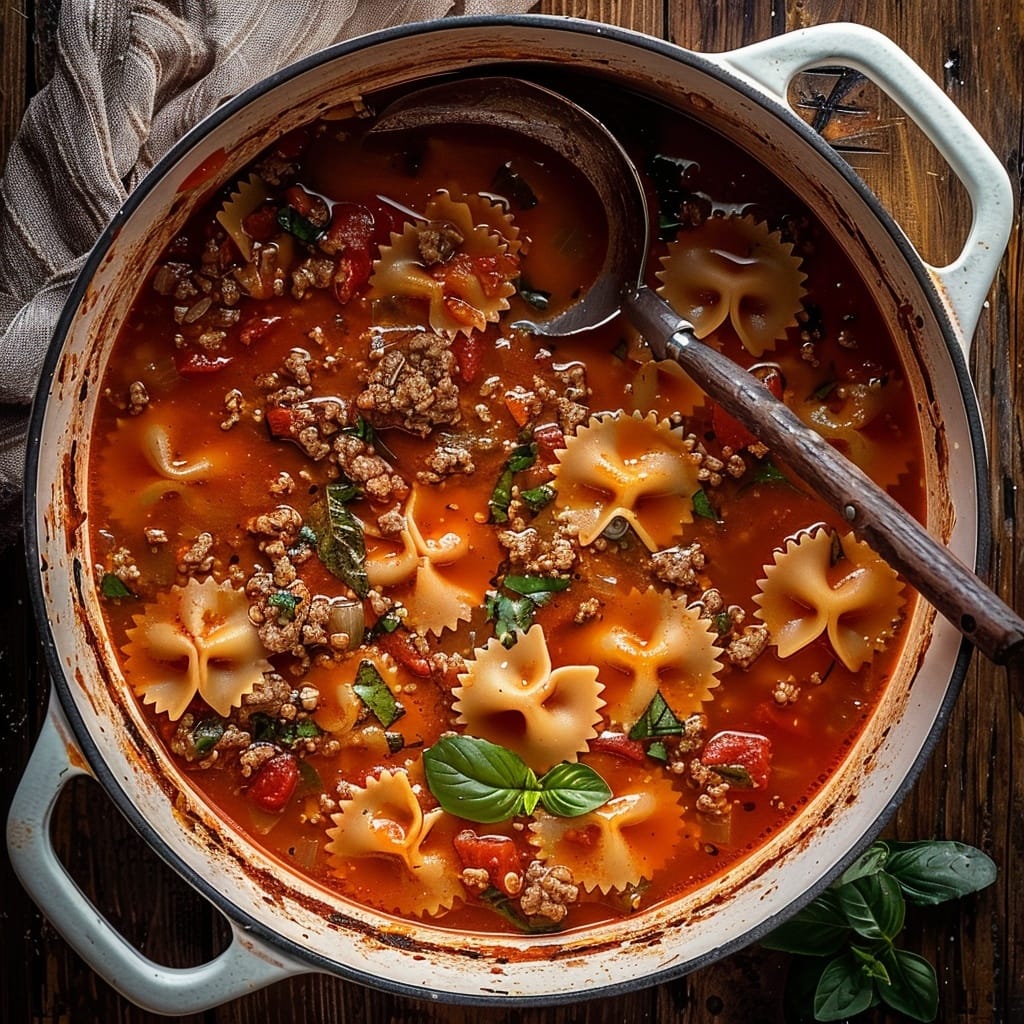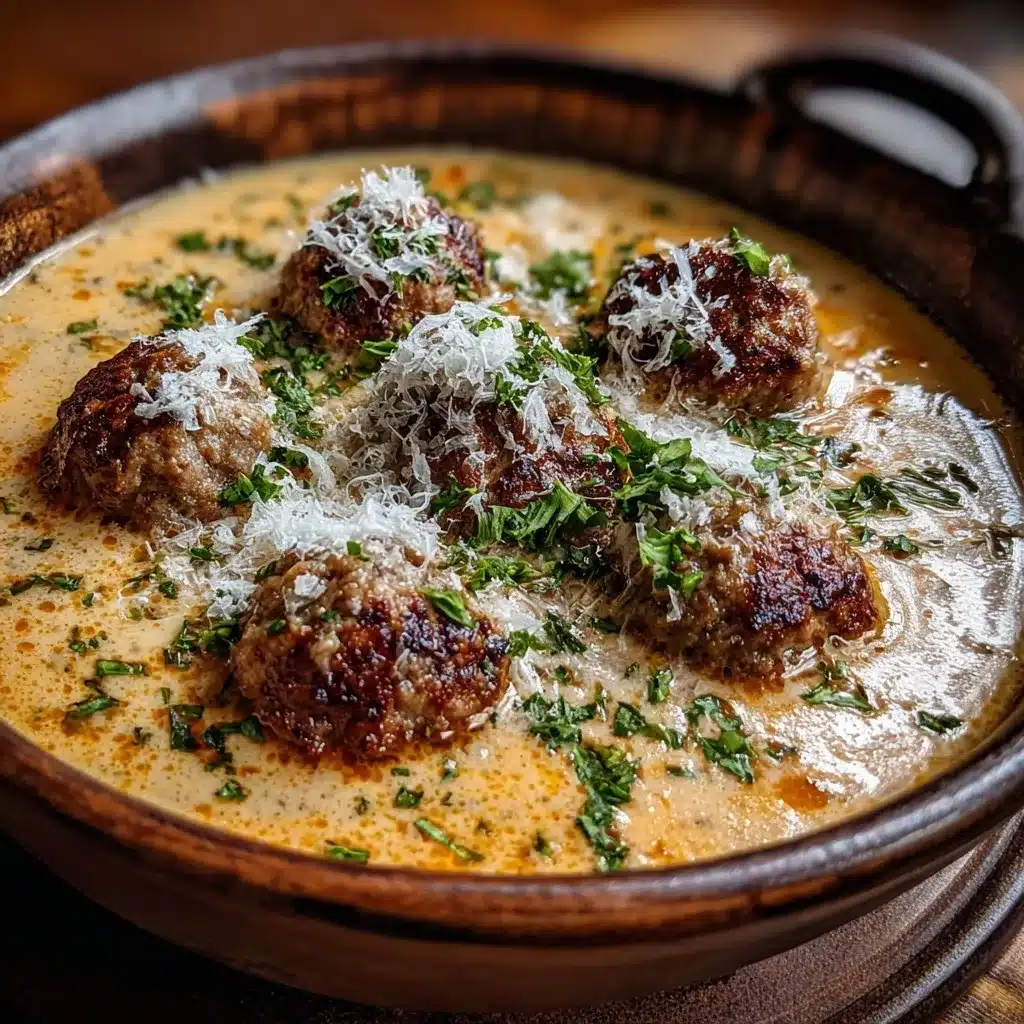When the weather cools down and you’re craving something warm, rich, and satisfying, nothing hits the spot quite like Lasagna Soup. It takes all the flavors you love from traditional lasagna—tender pasta, savory meat, tangy tomatoes, and gooey cheese—and transforms them into a cozy, one-pot soup. Unlike regular lasagna, which can feel heavy and time-consuming, lasagna soup is quicker to make, easier to customize, and every bit as comforting.
In this ultimate guide, you’ll learn everything you need to know about making the perfect lasagna soup at home. We’ll cover the best ingredients, step-by-step instructions, clever tips, and even variations for vegetarian, vegan, or gluten-free diets. You’ll also discover how it compares to classic lasagna, what to serve it with, and why this hearty soup is one of the most loved comfort food recipes in America.
Table of Contents
Lasagna Soup
What is Lasagna Soup?
At its core, lasagna soup is a deconstructed version of the traditional Italian lasagna dish. Instead of layering pasta, sauce, and cheese in a baking dish, you simmer all the elements together in a flavorful broth. The result is a hearty, spoonable meal that delivers all the richness of lasagna without the fuss. Think of it as lasagna’s quicker, cozier cousin.
Lasagna soup typically includes:
- A tomato-based broth infused with Italian herbs
- Pasta that mimics lasagna noodles (broken lasagna sheets, rotini, or fusilli)
- Ground meat like beef, sausage, or turkey
- A cheese mixture (usually ricotta, mozzarella, and Parmesan) added just before serving
This combination creates a comforting balance of savory, cheesy, and tangy flavors, with the broth tying everything together.
Why Lasagna Soup is a Must-Try Dish
Lasagna soup isn’t just another soup recipe—it’s the ultimate comfort food for busy nights and family gatherings. Here’s why it deserves a spot in your weekly meal plan:
- Quick and Easy – No hours of baking or layering required. Most recipes are ready in under 45 minutes.
- One-Pot Convenience – Minimal cleanup makes it perfect for weeknights.
- Versatile and Customizable – Works with beef, chicken, or plant-based substitutes. Pasta shapes can be swapped to suit your taste.
- Crowd-Pleaser – With its rich flavors and cheesy topping, it appeals to kids and adults alike.
- Perfect for Leftovers – The flavors deepen overnight, making it even more delicious the next day.
Whether you’re a seasoned cook or just getting started in the kitchen, lasagna soup is a dish you’ll come back to again and again.
Key Ingredients for Lasagna Soup
Ingredients You’ll Need
To create a hearty and flavorful lasagna soup, you’ll need a few staple ingredients that bring all the classic lasagna flavors into a comforting bowl:
- Pasta: Broken lasagna noodles or short pasta shapes like rotini, penne, or fusilli.
- Ground Meat: Ground beef or Italian sausage for a rich, savory base. Turkey or chicken can be used as lighter options.
- Tomatoes: Crushed tomatoes, tomato paste, or canned tomato sauce to build a robust broth.
- Broth: Chicken or beef broth to add depth and body to the soup.
- Herbs and Seasonings: Garlic, onion, oregano, basil, and bay leaf for that authentic Italian taste.
- Cheese: A mix of ricotta, mozzarella, and Parmesan added at the end for creaminess and indulgence.
These ingredients are what give lasagna soup its signature taste—similar to baked lasagna, but lighter and more spoon-friendly.
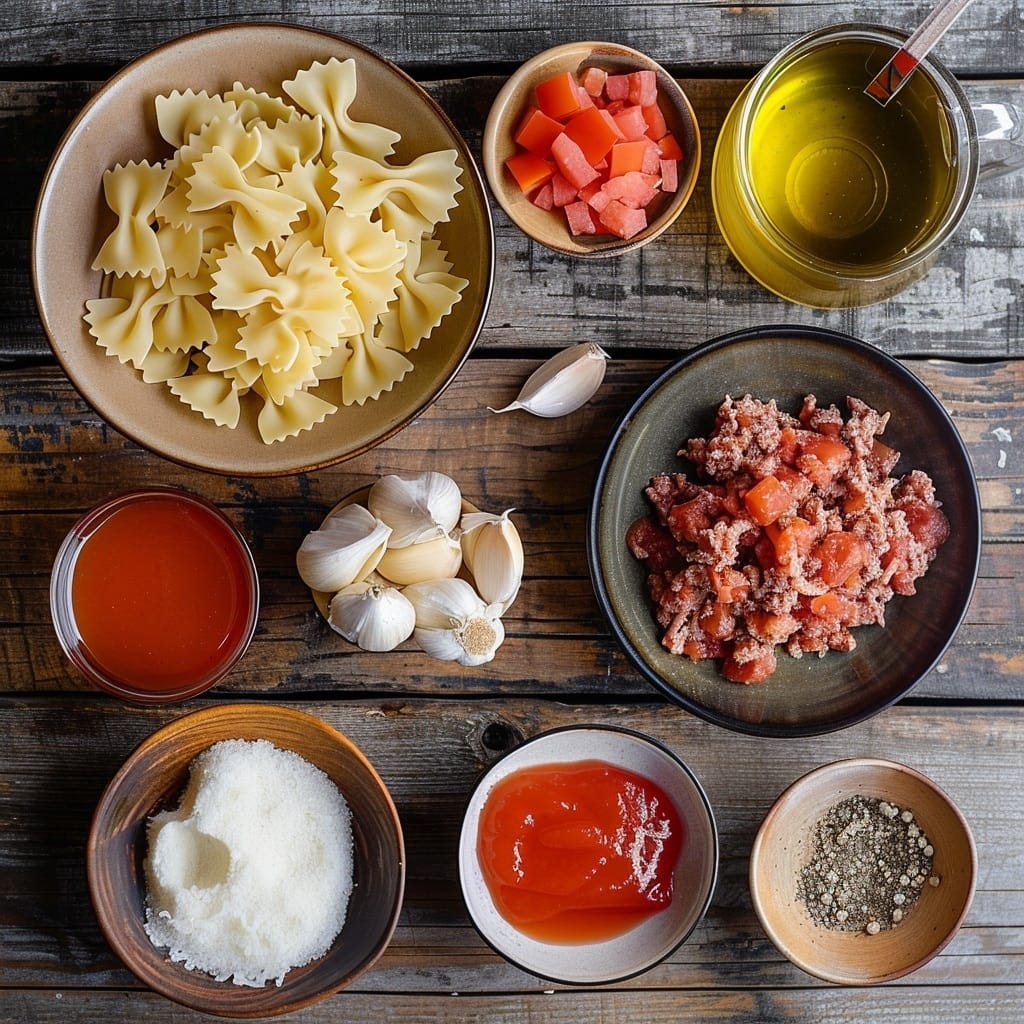
Substitutions and Variations for Different Diets
The beauty of lasagna soup is its flexibility—it can be easily adapted to fit different dietary needs without sacrificing flavor:
- Vegetarian Version: Swap the ground meat for lentils, mushrooms, or a plant-based meat alternative, and use vegetable broth instead of chicken or beef broth.
- Vegan Version: Use plant-based cheese or cashew cream instead of ricotta, and pair it with vegetable broth and meat alternatives.
- Gluten-Free Version: Replace regular pasta with gluten-free pasta made from rice, corn, or chickpeas.
- Low-Carb Version: Skip the pasta altogether and substitute with zucchini noodles or spiralized vegetables.
These simple tweaks make lasagna soup a versatile dish that anyone can enjoy, regardless of their diet.
Step-by-Step Guide to Making Lasagna Soup
Preparing the Base: Broth, Tomatoes, and Seasonings
The secret to a flavorful lasagna soup lies in the base. Here’s how to build rich layers of taste:
- Sauté the aromatics – Begin with olive oil, onion, and garlic in a large pot. Cook until softened and fragrant.
- Brown the meat – Add ground beef, sausage, or turkey. Cook until browned, breaking it into small pieces for even texture.
- Add tomato elements – Stir in tomato paste for depth, then add crushed tomatoes or tomato sauce. This creates the foundation of the soup.
- Season generously – Use Italian herbs like oregano, basil, thyme, and a bay leaf. Season with salt, pepper, and red pepper flakes if you prefer a little heat.
- Pour in broth – Add chicken or beef broth to balance the acidity of the tomatoes and give the soup a hearty body.
At this stage, the kitchen will already smell like lasagna night, but you’re just getting started.
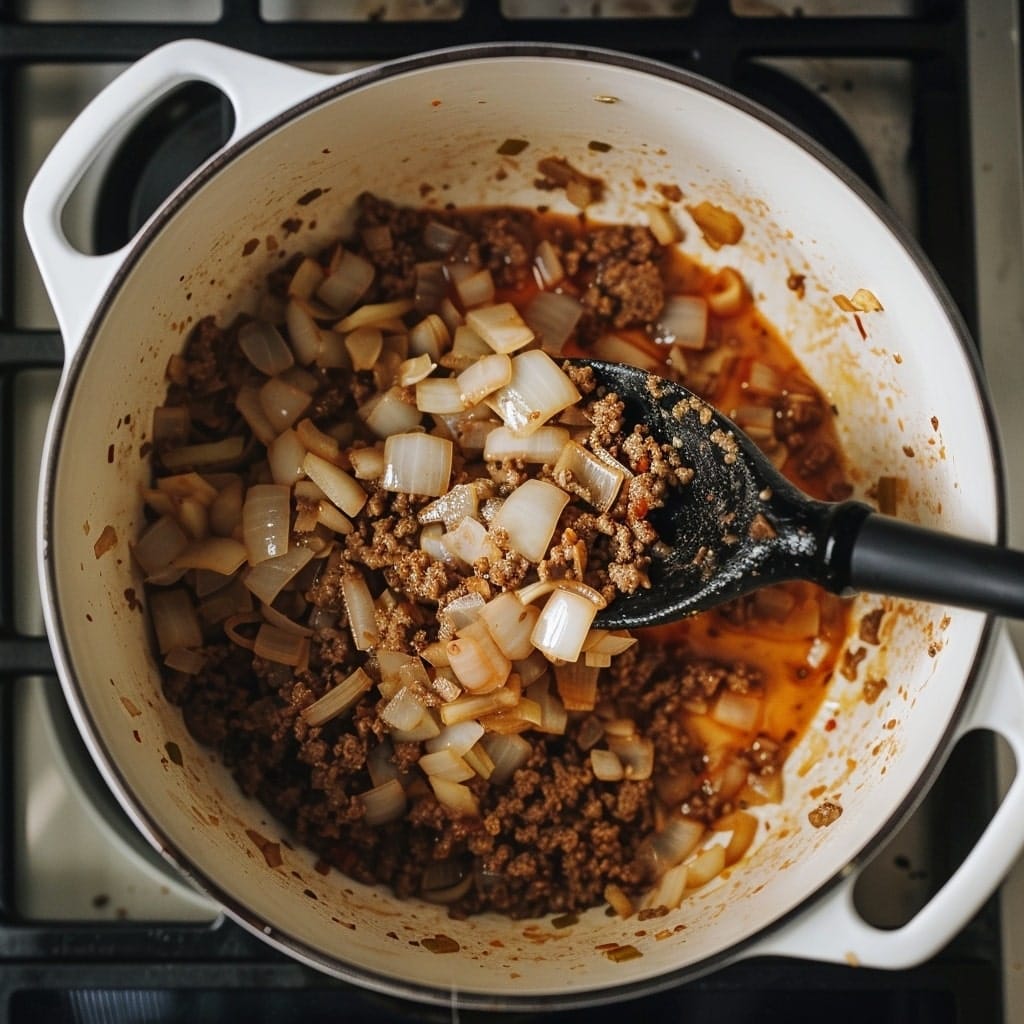
Cooking the Pasta and Layering Flavors
Now that your base is ready, it’s time to transform it into a true lasagna-inspired soup:
- Add pasta – Drop in broken lasagna noodles or your favorite short pasta. Cook until al dente, stirring occasionally to prevent sticking.
- Simmer gently – Let the soup bubble on low heat, giving time for the flavors to meld together.
- Adjust consistency – If the soup gets too thick, add more broth. If it feels too thin, let it simmer uncovered until reduced.
- Finish with cheese – Just before serving, stir in shredded mozzarella and Parmesan for a melty, creamy touch. Top each bowl with a dollop of ricotta for extra richness.
For a professional presentation, serve with a sprinkle of fresh basil or parsley and an extra grating of Parmesan.
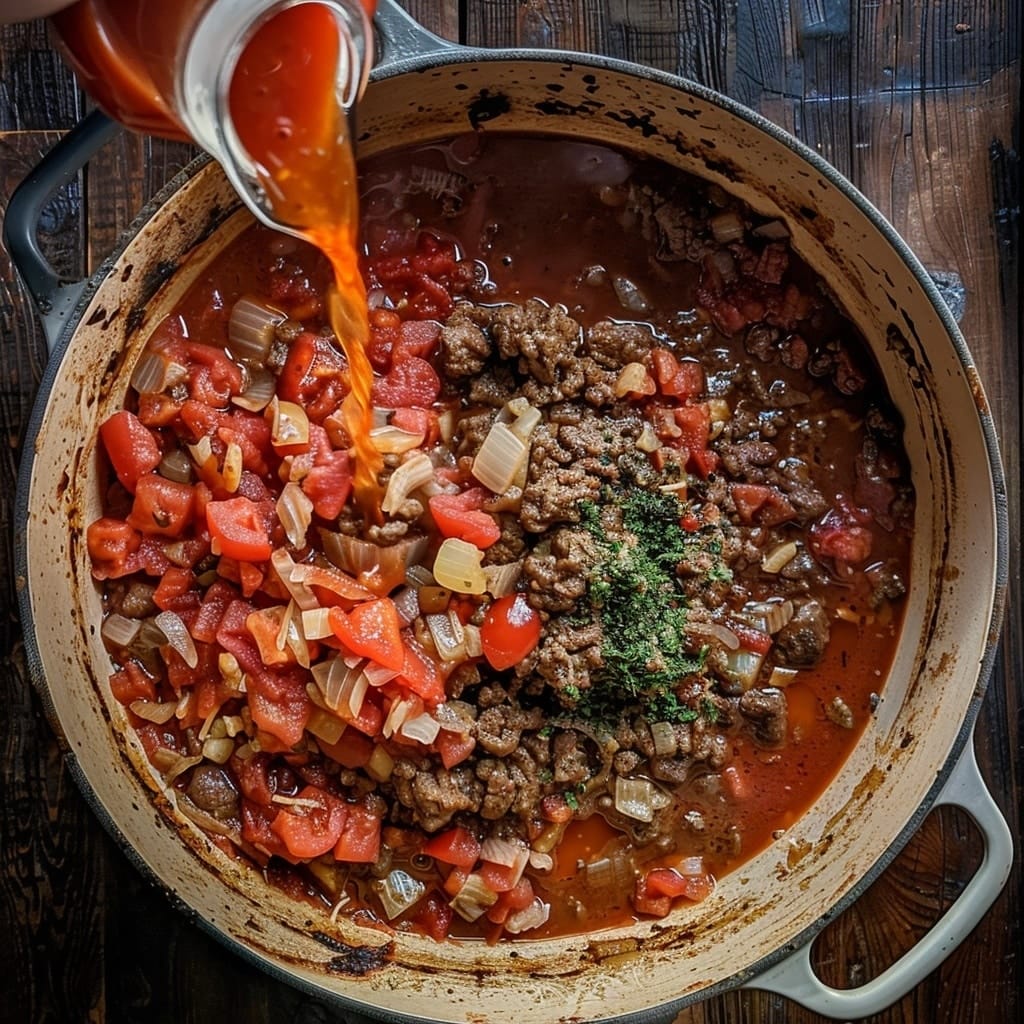
Tips and Tricks for the Perfect Lasagna Soup
Avoiding Common Mistakes in Lasagna Soup
Even though lasagna soup is simpler than traditional lasagna, a few missteps can keep it from turning out perfect. Here are mistakes to watch out for—and how to fix them:
- Overcooking the pasta – Pasta continues to absorb liquid even after cooking. To avoid mushy noodles, cook them until just al dente and consider boiling separately if you plan on storing leftovers.
- Using too much liquid – While it’s soup, you don’t want it watery. Balance the broth and tomatoes so the texture stays hearty, not thin.
- Skipping the cheese topping – The cheese is what gives this dish its true lasagna vibe. A dollop of ricotta and a sprinkle of mozzarella and Parmesan make all the difference.
- Forgetting to season in layers – Season as you go. Add salt and pepper while browning meat, then again when simmering the broth, to build depth of flavor.
- Not letting it rest – Allowing the soup to sit for 5 minutes before serving helps the flavors marry and thickens the broth slightly.
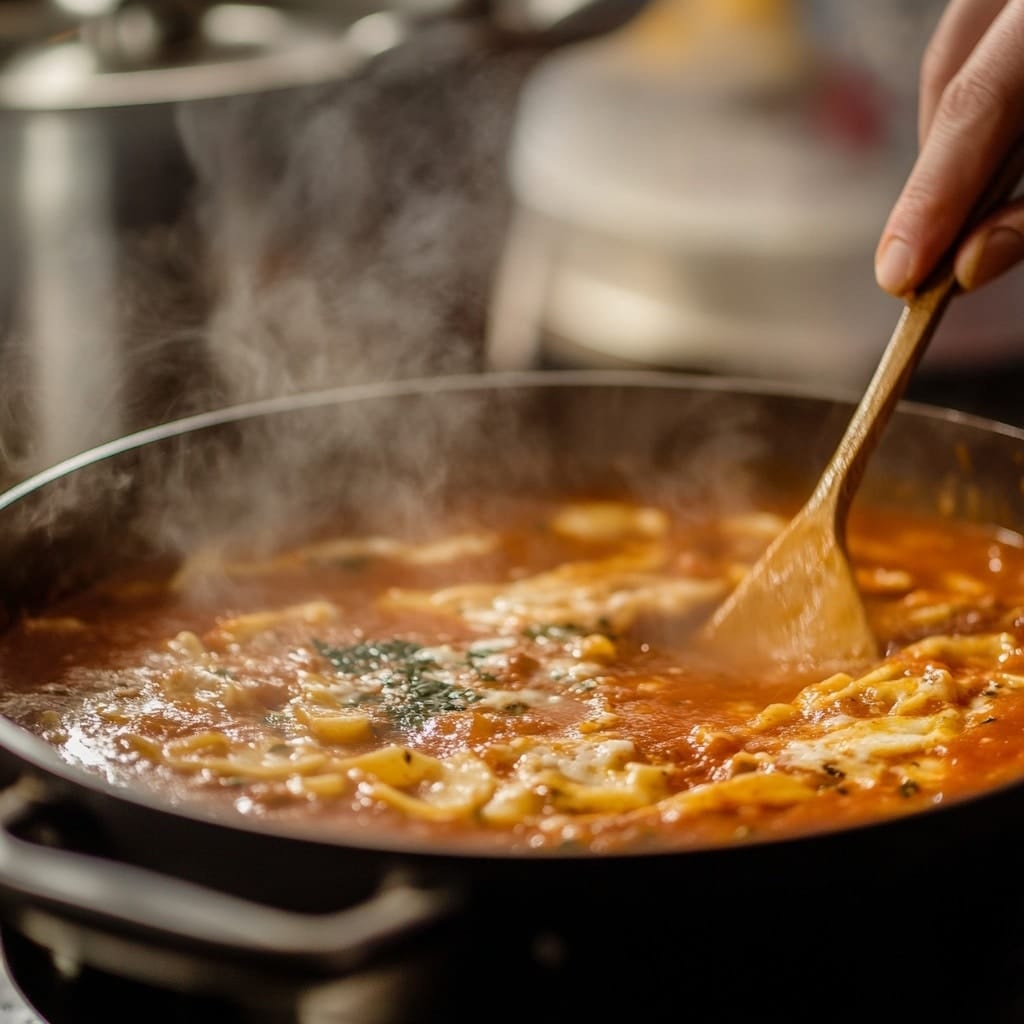
Expert Chef Tips for Extra Flavor
Want to take your lasagna soup from delicious to unforgettable? Try these expert-approved tricks:
- Use a sausage mix – Combine Italian sausage with ground beef for a bolder, richer flavor.
- Add a splash of wine – Deglaze the pot with red wine after browning the meat to add depth and complexity.
- Infuse with fresh herbs – While dried herbs are essential, finishing with fresh basil or parsley brightens the soup.
- Play with textures – Garnish with crunchy croutons or garlic bread on the side to contrast the creamy soup.
- Make it creamy – Stir in a splash of heavy cream or half-and-half for a velvety finish.
With these tips, you’ll serve a lasagna soup that tastes like it came straight from an Italian kitchen.
Variations of Lasagna Soup
Classic Lasagna Soup with Beef
The most popular version of lasagna soup is the classic beef-based recipe. Using ground beef or a mix of beef and Italian sausage gives the soup a rich, meaty flavor. Add in onions, garlic, and Italian herbs for depth, and finish with the classic trio of ricotta, mozzarella, and Parmesan for that authentic lasagna taste. This hearty option is perfect for family dinners and is guaranteed to satisfy meat lovers.
Vegetarian and Vegan Lasagna Soup Options
Not a fan of meat? No problem. Lasagna soup can be just as delicious without it:
- Vegetarian Version – Replace the beef with lentils, mushrooms, or zucchini for a plant-based protein boost. Use vegetable broth instead of chicken or beef broth.
- Vegan Version – Swap out dairy with cashew cream or vegan ricotta, and use plant-based mozzarella and Parmesan. A drizzle of olive oil before serving adds richness.
These lighter versions maintain the cozy comfort of lasagna soup while catering to different diets.
Gluten-Free and Low-Carb Adaptations
If you’re cutting carbs or avoiding gluten, lasagna soup can still fit into your meal plan:
- Gluten-Free – Choose gluten-free pasta made from rice, corn, or chickpeas. Be sure to adjust the cooking time, as gluten-free pasta can soften quickly.
- Low-Carb / Keto-Friendly – Skip the pasta and replace it with zucchini noodles, spaghetti squash, or even cabbage strips for a lighter, carb-conscious take.
These adaptations make lasagna soup versatile enough for nearly any dietary preference, without losing its comforting essence.
Serving Ideas and Pairings
The Best Side Dishes to Serve with Lasagna Soup
Lasagna soup is hearty on its own, but pairing it with the right side dishes can turn it into a complete meal. Here are some of the best accompaniments:
- Garlic Bread – Crispy on the outside and soft on the inside, garlic bread is the ultimate dipping partner for soaking up the flavorful broth.
- Side Salad – A light green salad with balsamic vinaigrette or Caesar dressing balances out the richness of the soup.
- Roasted Vegetables – Roasted zucchini, bell peppers, or asparagus add extra nutrition and a smoky depth of flavor.
- Bruschetta – Fresh tomatoes, basil, and olive oil on toasted bread provide a refreshing contrast.
- Antipasto Platter – Olives, marinated artichokes, and cured meats make an excellent starter for an Italian-inspired dinner.
Serving lasagna soup with any of these sides makes the meal more festive and satisfying.
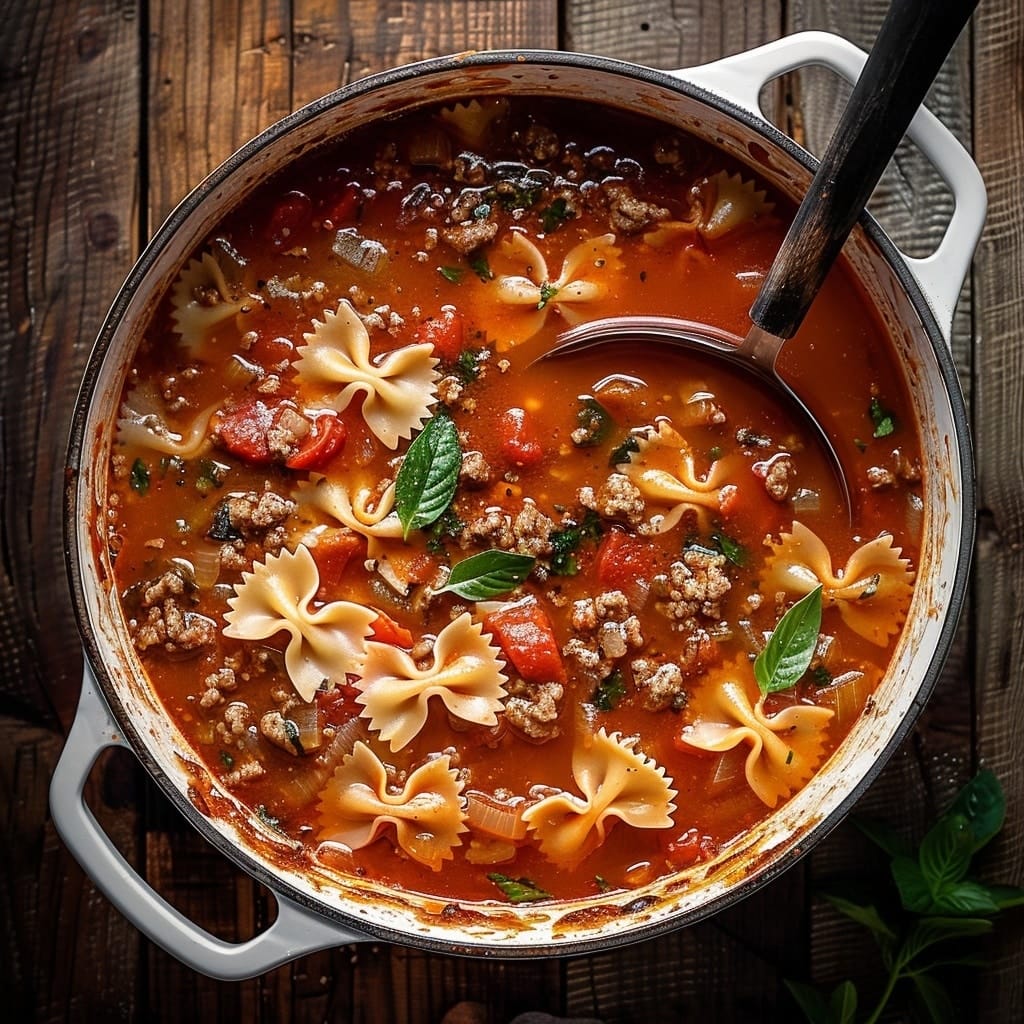
Garnishes and Toppings for Extra Flavor
The final touch of lasagna soup lies in the toppings. With just a sprinkle or dollop, you can elevate every bowl:
- Ricotta Cheese – A spoonful added right before serving gives a creamy, authentic lasagna feel.
- Fresh Basil or Parsley – Adds a burst of color and a fresh herbal note.
- Shaved Parmesan – A finishing touch of nutty, salty cheese enhances every bite.
- Red Pepper Flakes – For those who like a little heat, sprinkle lightly on top.
- Croutons or Breadsticks – Adds a crunch that balances the creamy soup.
These garnishes not only improve the flavor but also make the presentation beautiful, making your lasagna soup look like it came straight from a restaurant kitchen.
Lasagna Soup vs. Traditional Lasagna
Key Differences in Preparation and Taste
While lasagna soup and traditional lasagna share the same core ingredients, the preparation method sets them apart.
- Cooking Method – Traditional lasagna requires layering noodles, sauce, meat, and cheese in a baking dish and then baking for nearly an hour. Lasagna soup, on the other hand, is made in a single pot and ready in under 45 minutes.
- Texture – Baked lasagna is dense and structured, with defined layers. Lasagna soup is looser and brothier, offering a spoonable comfort food experience.
- Flavor Profile – Both dishes deliver the same Italian essence of tomatoes, herbs, and cheese. However, the soup version feels lighter, fresher, and more adaptable for different diets.
- Convenience – Lasagna soup is easier for weeknight meals, while baked lasagna often feels more like a weekend or special occasion dish.
In short, lasagna soup captures all the essence of lasagna but with less time and effort.
Why Lasagna Soup is a Faster, Easier Alternative
If you love lasagna but dread the prep work, lasagna soup is the answer. Here’s why:
- One-Pot Cooking – Everything cooks in one pot, minimizing cleanup.
- Time-Saving – No need for layering or long oven times; dinner can be on the table in under an hour.
- Family-Friendly – Kids and adults alike love it, and it’s easy to serve in individual bowls.
- Meal Prep Friendly – Leftovers store well in the fridge, and the flavors deepen after a day, making it perfect for next-day lunches.
Think of lasagna soup as the perfect balance between indulgence and convenience. It keeps the flavors of classic lasagna intact while offering a simpler cooking process.
Health Benefits and Nutritional Value
Calories, Protein, and Macronutrients
Lasagna soup may taste indulgent, but when prepared thoughtfully, it can fit into a balanced diet. Here’s a breakdown of what you’ll typically get in one serving (based on a classic beef and pasta recipe):
- Calories: Around 350–450 per serving, depending on portion size and cheese quantity.
- Protein: 20–25 grams, mainly from meat and cheese, making it a satisfying and filling meal.
- Carbohydrates: 35–45 grams from pasta and tomatoes, providing steady energy.
- Fat: 12–18 grams, depending on the type of meat and amount of cheese used.
- Fiber: 4–6 grams from vegetables and tomato base, supporting digestion.
This makes lasagna soup a balanced meal with a good ratio of protein, carbs, and healthy fats—especially when paired with a side salad or vegetables.
How to Make Lasagna Soup Healthier
If you want to enjoy lasagna soup without guilt, a few smart tweaks can make it lighter while keeping it delicious:
- Choose lean proteins – Use ground turkey or chicken instead of beef or sausage to reduce fat.
- Go heavy on veggies – Add zucchini, spinach, mushrooms, or bell peppers for extra nutrients and fiber.
- Switch to whole-grain pasta – Provides more fiber and keeps you fuller for longer.
- Lighten the cheese – Use part-skim mozzarella or ricotta to cut down on saturated fat.
- Control portions – Serve with a side salad or broth-based starter to keep portion sizes in check.
With these modifications, lasagna soup can be transformed into a nutrient-packed comfort food that doesn’t weigh you down.
FAQs
What ingredients for lasagna soup?
The essential ingredients for lasagna soup include ground beef or sausage, crushed tomatoes, tomato paste, chicken or beef broth, garlic, onion, Italian herbs, pasta (broken lasagna noodles or short pasta), and a cheese blend of ricotta, mozzarella, and Parmesan. Optional add-ins include spinach, mushrooms, or zucchini for extra flavor and nutrition.
What is the most delicious soup in the world?
Taste is subjective, but many food lovers consider lasagna soup one of the most delicious soups because it delivers the comfort of pasta, cheese, and hearty broth in every spoonful. Other globally loved soups include French onion soup, ramen, pho, and chicken noodle soup. Still, lasagna soup holds a unique spot as a cozy Italian-American favorite.
What is lazy lasagna?
Lazy lasagna is a simplified version of traditional lasagna where the ingredients are layered or mixed together without the careful stacking of noodles, sauce, and cheese. Lasagna soup is often referred to as a form of “lazy lasagna” because it brings together all the same flavors in a much easier, quicker preparation.
What are some tips for the perfect lasagna soup?
Cook pasta until al dente to avoid sogginess.
Season in layers, starting from browning the meat to simmering the broth.
Add cheese just before serving for the creamiest texture.
Garnish with fresh herbs like basil or parsley to brighten the flavors.
Let the soup rest for 5 minutes before serving to enhance its depth.
Conclusion
Why You Should Try Making Lasagna Soup at Home
Lasagna Soup is the ultimate comfort food for busy weeknights, cold evenings, or family dinners. It combines the bold flavors of lasagna with the simplicity of a one-pot soup. Whether you stick to the classic beef version, experiment with a vegetarian or vegan twist, or opt for gluten-free pasta, this dish adapts beautifully to your preferences.
Final Thoughts and Encouragement
Unlike traditional lasagna, which can feel heavy and time-consuming, lasagna soup gives you all the flavor in a fraction of the time. It’s versatile, crowd-pleasing, and nourishing. So, next time you crave something cozy yet easy, grab your pot, gather your ingredients, and treat yourself to a warm bowl of Lasagna Soup.
Print
Lasagna Soup – The Ultimate Guide to a Hearty Comfort Recipe
- Total Time: 45
- Yield: 6 servings 1x
Description
Lasagna Soup is the ultimate comfort food recipe that brings together all the classic flavors of traditional lasagna—savory ground beef, tender pasta, rich tomato broth, and gooey cheese—in a hearty, one-pot soup. Ready in just 45 minutes, this cozy Italian-inspired dish is perfect for weeknight dinners, family gatherings, or meal prep. Serve it with garlic bread or a fresh salad for a complete, satisfying meal.
Ingredients
8 oz bowtie pasta (or broken lasagna noodles)
1 lb ground beef (or Italian sausage)
1 onion, diced (optional)
3 cloves garlic, minced
1 can (28 oz) diced tomatoes
2 tbsp tomato paste
3 cups chicken broth (or beef broth)
2 cups tomato sauce
1 tsp Italian seasoning
1 tsp dried oregano
Salt and pepper to taste
1 tbsp olive oil
Fresh basil for garnish
1 cup ricotta cheese (for topping)
1 cup shredded mozzarella cheese (for topping)
½ cup grated Parmesan cheese (for topping)
Instructions
Heat olive oil in a Dutch oven over medium heat. Sauté onion and garlic until softened.
Add ground beef (or sausage) and cook until browned, breaking it into small pieces. Drain excess fat if needed.
Stir in tomato paste, then add diced tomatoes, tomato sauce, chicken broth, and seasonings (Italian seasoning, oregano, salt, pepper).
Bring to a boil, then reduce heat and let simmer for 10 minutes to build flavor.
Add pasta directly to the pot and cook until al dente (8–10 minutes). Stir occasionally to prevent sticking.
Adjust seasoning to taste and remove from heat.
Serve hot with a dollop of ricotta cheese, shredded mozzarella, Parmesan, and fresh basil.
Notes
Pasta Tip: If you’re planning leftovers, cook the pasta separately and add it to individual bowls. This prevents it from getting soggy as it sits in the broth.
Protein Variations: Ground turkey, chicken, or Italian sausage work just as well as beef. For a vegetarian version, swap in lentils or mushrooms.
Make It Creamy: Stir in ½ cup of heavy cream or half-and-half before serving for a rich, velvety texture.
Storage: Store leftovers in the fridge for up to 3 days. Reheat gently on the stovetop, adding a splash of broth if the soup has thickened.
Freezing: Freeze without pasta for up to 3 months. Thaw overnight and cook fresh pasta when ready to serve.
Cheese Options: Ricotta is traditional, but cottage cheese or mascarpone can also be used for a creamy finish.
Spice It Up: Add red pepper flakes or a pinch of cayenne for a subtle kick.
- Prep Time: 15
- Cook Time: 30
- Category: Easy Recipes
- Cuisine: Italian-American
Nutrition
- Serving Size: 6 servings
- Calories: 410
- Sugar: 7 g
- Sodium: 980 mg
- Fat: 16 g
- Saturated Fat: 7 g
- Unsaturated Fat: 8 g
- Carbohydrates: 42 g
- Fiber: 5 g
- Protein: 24 g
- Cholesterol: 65 mg

